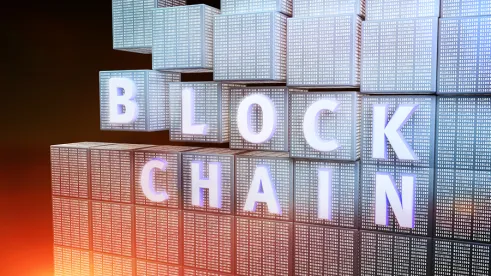Content owners and their attorneys have been enthusiastically anticipating the use of blockchain as a mechanism for royalty accounting, recording the chain of title of intellectual property interests, and protecting, tracking and administering IP.
The enthusiasm is a little less vigorous, however, when the topic turns to the use of blockchain as a vehicle for content distribution. Some of those discussions are still appealing to content owners and their counsel as they focus on the use of blockchain as a means of effectuating a decentralized digital rights management-type system to allow distribution of content to authorized users in a secure way. Copyright anxiety arises, however, with the recognition that the technology can also be used to facilitate the distribution of infringing content, notably in the form of anonymous transactions that are embodied in a block in a permanent and immutable manner.
Can content be embedded in a blockchain? “That will never happen,” some may think. Well, it actually already has. In fact, the phrase “‘The Times 03/Jan/2009 Chancellor on brink of second bailout for banks’” was embedded by a miner in the genesis block of the Bitcoin blockchain – the very first block in the chain! While simple in nature, more sophisticated examples of content embedded in the Bitcoin blockchain are detailed in a 2014 blog post by Ken Shirriff, a technology blogger. In that post, Shirriff discusses a wide variety of material embodied in the Bitcoin blockchain, ranging from a photo of, and tribute to, Nelson Mandela, to the Bitcoin logo, to Valentine’s Day messages and even to a complete copy of Satoshi Nakamoto’s seminal Bitcoin paper.
Further, blockchain and the ability to incorporate content “on chain” have continued to evolve since that 2014 post. There have been a number of recent papers discussing various issues relating to “on-chain” content distribution. (For example, see here, here and here.) In addition, there are now tools available that are designed to facilitate the dissemination and archiving of on-chain content. (See, for example, this.) Decentralized content distribution methodologies such as Steemit and others are launching, with many building on the bittorrent and IPFS protocols to take advantage of the ability to store encrypted content in a decentralized way across a network of nodes. Perhaps one of the most sophisticated applications is d.tube, which boasts that because of its decentralized nature, it is “resistant to censorship” and cannot enforce guidelines. It seems inevitable that a d.tube-related intellectual property dispute will be litigated in the near future.
Of course, just the mention of bittorrent raises the blood pressure of copyright owners and their attorneys. Chasing a population of anonymous and tech-savvy infringers, in a world where content is distributed in a peer-to-peer decentralized manner in an encrypted and immutable form, is a copyright owner’s nightmare. First-impression copyright issues abound.
As Shiffrin noted in his blog post regarding the Mandela image and other content embedded on the Bitcoin blockchain, every node on the chain likely has the encrypted and digital representation of that content on their servers. Assuming the Mandela image is infringing, numerous copyright issues come to mind. For example, what liability is associated with a node’s storage of that image – albeit in the form of an encrypted block on the chain? Is that direct copyright infringement? Contributory infringement? Is there sufficient volitional activity, or is this akin to the 1995 Netcom decision and its progeny (see, for example, this and this) (where the automated process of distribution across nodes (or copying and distribution carried out by the system but initiated by the user) insulated the provider against a claim of direct infringement)? Still, it is important to note, that when considering this issue, courts examine the purpose and general use of the service in question, and have in the past found “volitional conduct” in certain cases, such as where a service was designed solely to collect and sell copyrighted material.
Another question arises: will the controversy over the applicability of the “server” test of the Perfect 10 decision be relevant here, or, given the recent decision in Breitbart News Network, will that analysis be limited to certain isolated factual circumstances related to the infringement of the “display right” as opposed to the widespread reproduction associated with the peer-to-peer dissemination over the internet? Without the full facts of a live dispute before us, a proper analysis is difficult, yet it remains to be seen whether the “server test,” which was originally applied to images stored on third-party servers and accessed by inline linking, would be applicable to content stored in a decentralized manner (i.e., both on third-party servers and presumably on the accused infringer’s servers).
In addition, there are many questions regarding the application of the Digital Millennium Copyright Act (DMCA) to blockchain. How will takedown requests work in this new world? How can a copyright holder identify the location of the infringing work? And how can a DMCA takedown request be complied with when the content at issue is immutably embedded in a blockchain?
And, of course, in terms of remedies, how can injunctive relief be afforded in this scenario where again, the “ledger” – the on-chain copy of the infringing work – is permanent and immutable?
While the idea of using blockchain for authorized on-chain distribution of content could be very appealing for emerging business models, the technology and tools will also be available to those intent on using, or facilitating the use of, copyrighted content without authorization. And that will present a major challenge for copyright holders in the very near future.



 />i
/>i
